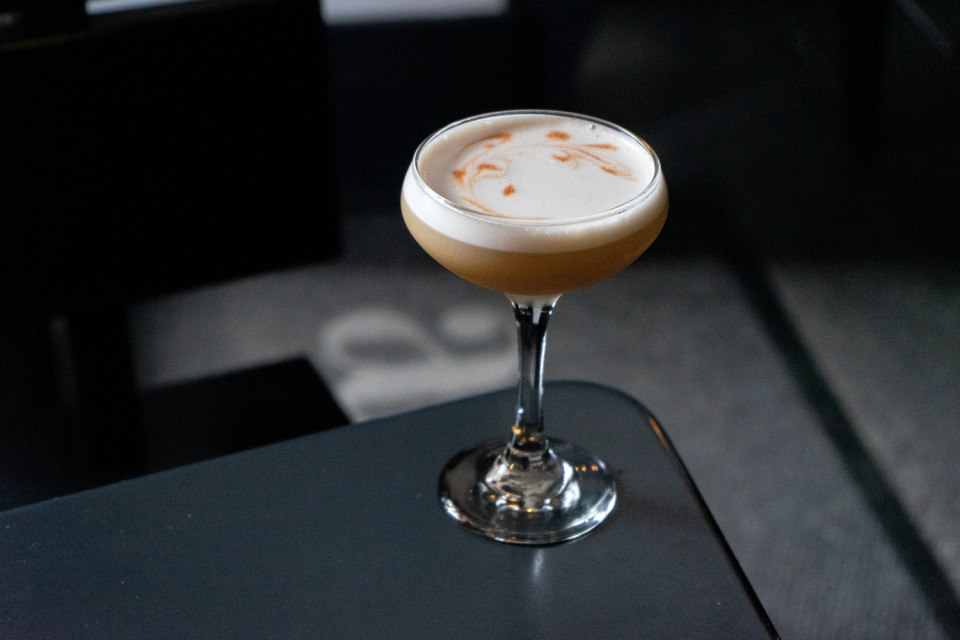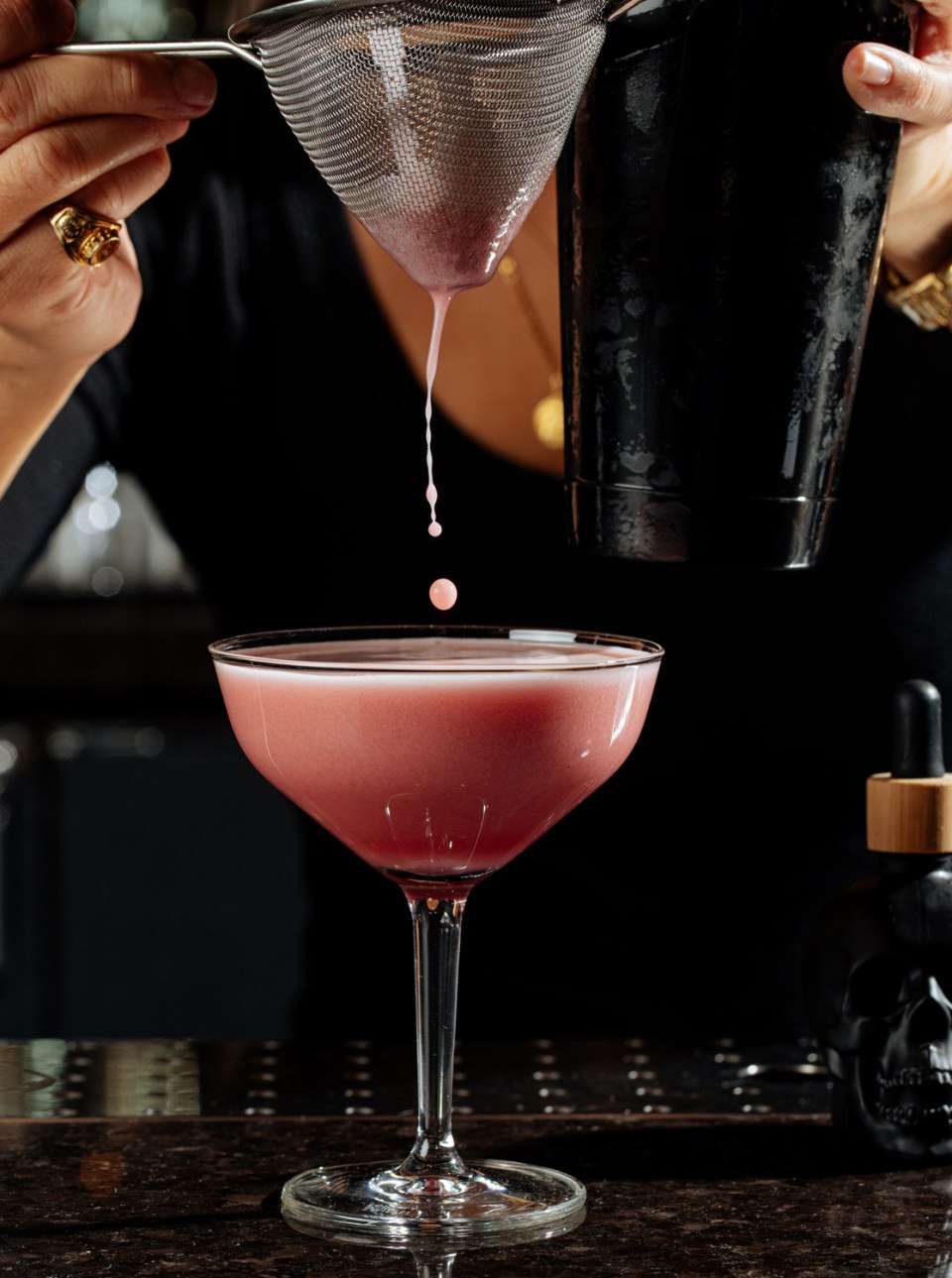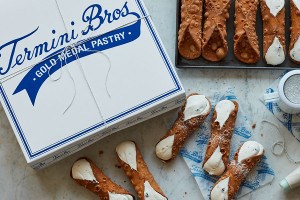The Clover Club, a Classic Cocktail Born in Philly, Is Having a Moment. Here’s Where to Drink It
These bars are bringing the frothy, pink drink into a whole new era.

“Put an Egg on It” at A.bar / Photograph courtesy of High Street Hospitality
Drinking in Philadelphia has come a long way from throwing back Citywides. While it seems craft beer tastes are in limbo, spirits are in ascendance with the slow (but progressive) undoing of Prohibition legacy laws and the rise of Philly drinkers who are adventurous, discerning, and brand-aware. Once Act 39 in 2016 allowed for spirits, wine, and beer to be sold and consumed on-site by their own producers in Pennsylvania, more breweries, wineries, and distilleries have opened their own bars and tasting rooms. Since then, Philadelphia has seen a boom in bar programs offering new riffs on the classics and plenty of Instagram-ready high-concept cocktails. With these new menus influencing the city’s drinking culture, we thought it was time to revisit a Philly classic and track its evolution from a pre-Prohibition cocktail to its recent, modern-day aesthetic.
So say hello (again) to the Clover Club. It’s a gin cocktail that’s been around since the late 1800s, named after a one-time private men’s club at the Bellevue-Stratford Hotel here in Philadelphia, and has even lent its name to mixology legend Julie Reiner’s Brooklyn bar.
The original Clover Club is tart and refreshing, made with gin, raspberry, lemon juice and egg whites. First, the egg is cracked and separated. The white is then mixed with the citrus, berries and ice, and shaken until they make a nice froth. Next, the gin is added and the whole thing is shaken again, resulting in a perfectly cold and colorful drink that’s served up (no ice) in a coupe glass.
We decided to do a Philadelphia Clover Club crawl at popular drinking spots around town to determine how well this classic is faring in today’s modern barroom, meet the bartenders who love making it, and collect the best, most up-to-date takes on its classic formula — from infusing Pennsylvania ingredients to developing non-alcoholic versions fit for a growing crop of sober consumers.
Want to know what we found? Well step right this way …
Southgate
Graduate Hospital
You might be surprised that a neighborhood bar like Graduate Hospital’s Southgate has not one, but two Clover Clubs on the menu. But according to owner Peter Hwang, since opening back in 2015, cocktails have gained so much traction that they outsell beer at his 18th Street restaurant. Curious guests come in excited to try drinks once created by former managers Juan Bustamante and Danny Kwon, especially those named after popular Korean movies.
Southgate’s “My Sassy Girl” ($15) was created by Kwon, a former front-of-house manager, and is a play on the traditional version with Roku gin, soju, creme de Violette, Luxardo Maraschino, and egg white. It’s “a little bit sweet, sour, and flip-esque” says Hwang. Roku is a Japanese gin that has fewer herbal notes and allows for more versatility. Not only does the drink stay true to its original — light, foamy and refreshing — but it’s in keeping with the theme of the restaurant according to Hwang.
Then there’s the “Handmaiden” ($15), created by Bustamante, a former beverage director. This is a version sans egg white (read: vegan), made with Beefeater gin, Luxardo Maraschino, raspberry, lavender, Dolin vermouth, and absinthe. Similar to a “Pink Lady,” this is a stronger take that leans into the feminine visuals of the classic Clover Club yet drinks like a spritz. And it raises an important debate: Does a Clover Club need egg white (or an equally full, silky texture) to provide that iconic feel?
Cicala at the Divine Lorraine
North Broad
“Cocktail sales have gone through the roof,” says chef Joe Cicala, who’s seeing guests at his namesake restaurant go for dry cocktails to accompany the pasta-rich menu. It was a former bartender who suggested that Cicala add a Clover Club to the menu. Cicala’s “The Pleasure Club of Fiumedinisi” ($17) stays true to the velvety, sweet-and-sour formula — and has remained one of the most popular drinks on the menu since its inception. It’s a visually stunning drink that fits the old-world elegance and luxury of its home at the Divine Lorraine. Cicala’s citrus-forward take also calls back to the restaurant’s southern Italian focus, taking inspiration from Sicilian ingredients and Italian spirits and liqueurs. “The Pleasure Club” uses blood-orange syrup instead of raspberry and clementine juice (peep their signature symbol modeled after chef Cicala’s grandmother, Clementina) as the primary citrus or acid instead of lemon. Pair it with Cicala’s pumpkin icebox cake for a full Philly experience. (The icebox was invented by a local farmer.)

Banh Mi and Bottles’ take on the Clover Club: “Khaleesi Means Queen” / Photograph by Steve Harner
Banh Mi & Bottles
South Street
Over at Banh Mi and Bottles, owner/operator Tuan Phung also loves to “take a classic but be creative, still have a story behind it, and make it new.” For the debut of their new bar program earlier this year, Phung collaborated with Ranstead Room’s Nico Diaz to develop new cocktail recipes to pair with the food, adding ingredients common to both Vietnam and the Caribbean, plus local spirits like Bluecoat gin. Their “Khaleesi Means Queen” ($16) builds off the traditional Clover Club for a creamier, tropical version with coconut cream and raspberry jam. It drinks like the best strawberry milk of your childhood, and if you have a sweet tooth, this is absolutely the Clover Club for you.
A.kitchen & A.bar
Rittenhouse
For purists like Harry Jamison, general manager at a.kitchen+bar in Rittenhouse, the Clover Club has a combination of flavors that everyone loves — and those few ingredients can’t be skipped, especially the egg white. He’s also partial to vermouth.
“The vermouth provides body, fights against the [raspberry] tartness a little bit, and also has botanicals that play nicely with the gin,” says Jamison. “When I make the drink for myself, I prefer to use blanc vermouth rather than dry because I think that extra touch of sugar really helps to fatten up the drink and bring the raspberry note forward.”
His off-menu “Put an Egg on It” ($16) is still airy and refreshing and is a perfect homage to autumn with fall ingredients and warming spices like saffron liqueur, pear-balsamic shrub, cinnamon syrup, and an Angostura bitters garnish to finish it off.

Clover Club at W Philadelphia / Photograph courtesy of W Philadelphia
W Philadelphia
Center City
W Philadelphia’s “Philadelphia Insider” menu has an off-menu Clover Club (just called the “Clover Club”) developed by R&D’s Resa Mueller that adds dry vermouth for more of an herbal complexity, and toned-down sweetness which gives this cocktail a distinctive tart and silky finish, according to Allysha Hackett, director of food and beverage at W Philadelphia.
“I think this cocktail represents Philly because it’s somewhat of an underdog and it punches way over its weight class,” she says. “What’s more, Philadelphia is a flavor town in both our kitchens and our bars.”
For her, making the Clover Club extra special means incorporating Philadelphia’s own Bluecoat Gin, maintaining the integrity of flavors with fresh juices and syrups, and ending with a strong dry shake.
Giuseppe & Sons
Rittenhouse
Michael McCaulley, director of beverages for Schulson Collective, has figured out a mocktail Clover Club that preserves botanical notes using Sobrii 0-Gin.
“Sobrii from Canada has mastered the kick and dryness you’d expect from a London Dry style of gin,” says McCaulley. “It has notes of juniper, pine and ginseng with a slight coriander bite and a great mouthfeel that stands up to its alcoholic counterparts.” Like Jamison, he believes fresh ingredients like eggs, lemon juice and raspberry syrup are key, and follows the traditional Clover Club recipe, but with more raspberry syrup in his “Clover ‘Sub’” ($8) zero-proof rendition.

“Post Clover Club” / Photograph courtesy of Post Haste
Post Haste
Kensington
Fred Beebe at Post Haste is not shy about his fanaticism for the Clover Club’s fabled history — especially the parts focused on Philly.
“The Clover Club represents one of Philadelphia’s contributions to the world of cocktails,” he asserts. “Much like the ‘Last Word’ to Detroit, it establishes Philadelphia as a city that has long been a center of culture and commerce. The Clover Club represents Philly’s long history of excellent dining and drinking destinations.”
Beebe is a firm believer in a well-made version that balances brightness, has layers of texture, and is topped with a frothy pillow. His “Post Clover Club” ($13) sources big, rich flavors with ingredients from the East Coast, which Beebe says creates a space for experimentation. He uses yuzu, a bolder more complex citrus flavor, which is locally grown outside of Trenton; a full ounce of house-made raspberry syrup from Green Meadow Farm berries; Snug Harbor Gin made at New Liberty Distilling nearby; and Stone & Key Revolutionary Dry Vermouth, a bianco botanical vermouth made in Montgomeryville. For a vegan version, Post Haste uses Fee Foam, an egg-white substitute.


